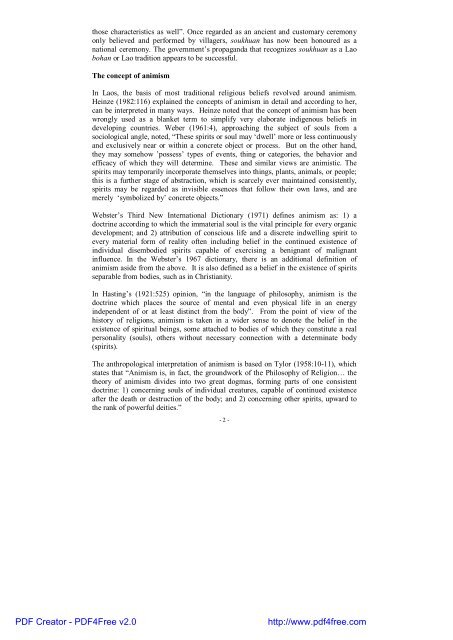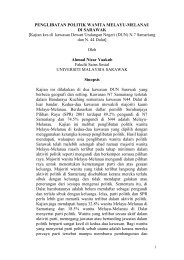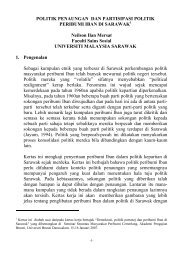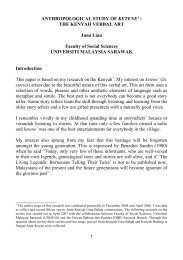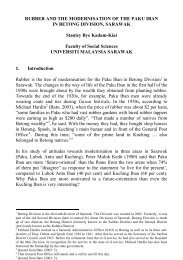OF SOUKHUAN AND LAOS Elena Gregoria Chai Chin Fern Faculty ...
OF SOUKHUAN AND LAOS Elena Gregoria Chai Chin Fern Faculty ...
OF SOUKHUAN AND LAOS Elena Gregoria Chai Chin Fern Faculty ...
You also want an ePaper? Increase the reach of your titles
YUMPU automatically turns print PDFs into web optimized ePapers that Google loves.
those characteristics as well”. Once regarded as an ancient and customary ceremony<br />
only believed and performed by villagers, soukhuan has now been honoured as a<br />
national ceremony. The government’s propaganda that recognizes soukhuan as a Lao<br />
bohan or Lao tradition appears to be successful.<br />
The concept of animism<br />
In Laos, the basis of most traditional religious beliefs revolved around animism.<br />
Heinze (1982:116) explained the concepts of animism in detail and according to her,<br />
can be interpreted in many ways. Heinze noted that the concept of animism has been<br />
wrongly used as a blanket term to simplify very elaborate indigenous beliefs in<br />
developing countries. Weber (1961:4), approaching the subject of souls from a<br />
sociological angle, noted, “These spirits or soul may ‘dwell’ more or less continuously<br />
and exclusively near or within a concrete object or process. But on the other hand,<br />
they may somehow ’possess’ types of events, thing or categories, the behavior and<br />
efficacy of which they will determine. These and similar views are animistic. The<br />
spirits may temporarily incorporate themselves into things, plants, animals, or people;<br />
this is a further stage of abstraction, which is scarcely ever maintained consistently,<br />
spirits may be regarded as invisible essences that follow their own laws, and are<br />
merely ‘symbolized by’ concrete objects.”<br />
Webster’s Third New International Dictionary (1971) defines animism as: 1) a<br />
doctrine according to which the immaterial soul is the vital principle for every organic<br />
development; and 2) attribution of conscious life and a discrete indwelling spirit to<br />
every material form of reality often including belief in the continued existence of<br />
individual disembodied spirits capable of exercising a benignant of malignant<br />
influence. In the Webster’s 1967 dictionary, there is an additional definition of<br />
animism aside from the above. It is also defined as a belief in the existence of spirits<br />
separable from bodies, such as in Christianity.<br />
In Hasting’s (1921:525) opinion, “in the language of philosophy, animism is the<br />
doctrine which places the source of mental and even physical life in an energy<br />
independent of or at least distinct from the body”. From the point of view of the<br />
history of religions, animism is taken in a wider sense to denote the belief in the<br />
existence of spiritual beings, some attached to bodies of which they constitute a real<br />
personality (souls), others without necessary connection with a determinate body<br />
(spirits).<br />
The anthropological interpretation of animism is based on Tylor (1958:10-11), which<br />
states that “Animism is, in fact, the groundwork of the Philosophy of Religion… the<br />
theory of animism divides into two great dogmas, forming parts of one consistent<br />
doctrine: 1) concerning souls of individual creatures, capable of continued existence<br />
after the death or destruction of the body; and 2) concerning other spirits, upward to<br />
the rank of powerful deities.”<br />
- 2 -<br />
PDF Creator - PDF4Free v2.0<br />
http://www.pdf4free.com


